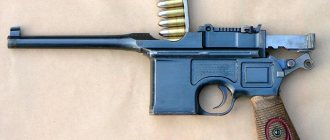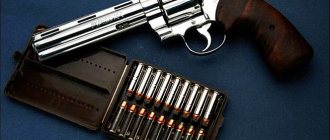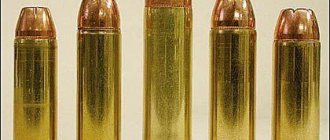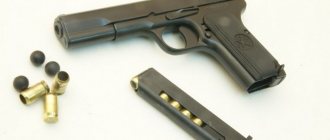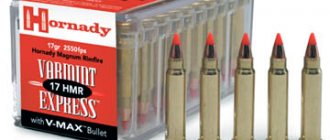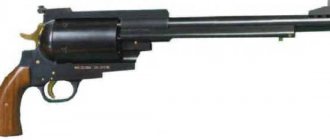Cartridge .45-70 Government WW (Winchester-Western)
Smoky
This cartridge was loaded with black powder for the Springfield Model 1873 rifle.
.45 - caliber in inches. 70 is the weight in grains of black powder.
Sprinkfield Arsenal
The .45-70 rifle cartridge, also known as the .45-70 Goverment, was developed by the Springfield Arsenal for the US Army. Used in the Model 1873 Springfield rifle, known to collectors as the "Trapdoor Springfield".
As is the case with many military ammunition, the .45-70 became a hit among sportsmen and hunters. The production and use of the .45-70 cartridge continues to this day. Today, the traditional load of 405 grains (26.2 g) is considered sufficient for any North American big game within its working range, including large bears. Along with this, it does not damage smaller animals such as deer due to the low velocity of the bullet.
Valued for hunting big game in brush or heavy timber where the range of operation is generally short.
The .45-70, loaded with the appropriate bullets at the appropriate velocities, was used to hunt the African "Big Six". The trajectory of the bullets is very steep.
At the dawn of the release of this cartridge, shooters had to carefully calculate the trajectory and wind corrections when shooting over long distances.
Currently, Hornady, Winchester and Prvi Partizan are among the leaders in .45-70 production.
With a line of bullets from 300 to 405 grains, Flat Nose, Soft Point, Hollow Point, and Full Metal Jacket.
(This cartridge was originally designed for black powder and was adopted by the US Army in 1873 along with the Springfield trapdoor rifle. In 1892 he was replaced by him .30-40 Krag, first smokeless gunpowder cartridge in that country. Currently is still made but loaded with smokeless powder. As in all American black gunpowder cartridges, 45 is the diameter of the bullet in hundredths of an inch, and 70 is the weight in black powder grains it carried. The. 45-75 Sharps, is an identical cartridge except for the bullet, longer in length and in flat shape.)
| Chuck type | rifle cartridge |
| Manufacturer country | USA |
| Service history | |
| Used | USA |
| Wars and conflicts | Spanish-American War |
| Production history | |
| Time of creation | 1873 |
| Characteristics | |
| Chuck length, mm | 64,8 |
| Real bullet caliber, mm | 11,6 |
| Bullet weight, g | 19,44 |
| Initial bullet speed, m/s | 487 |
| Bullet energy, J | 2304 |
| Test barrel length, mm | 24 inches |
| Sleeve parameters | |
| Sleeve length, mm | 53,5 |
| Case neck diameter, mm | 12,2 |
| Sleeve base diameter, mm | 12,8 |
| Sleeve flange diameter, mm | 15,4 |
source: https://ru.wikipedia.org/wiki/.45-70
source: https://www.municion.org/
source: https://www.sgammo.com/catalog/rifle-ammo-sale/45-70-govt-ammo
Decoding
Let's start with the fact that its full name is caliber .45-70-405. This is not an empty set of numbers, but an accurate source of valuable knowledge for any specialist. Having correctly deciphered the name, you can find out that the diameter of the bullet is 0.458 inches or 11.63 millimeters. The weight of gunpowder in such a cartridge is 70 grains (this is an outdated unit of mass, approximately equal to the mass of one grain of barley, sometimes used by specialists) or 4.54 grams. Well, the lead bullet that the cartridge is loaded with weighs 405 grains, or 26.2 grams.
As you can see, the name itself encodes quite detailed characteristics of the caliber and the corresponding cartridges.
Story
Profile and Stamp
The .45-70's predecessor was the .50-70-450 cartridge, adopted in 1866 and used until 1873 in a variety of rifles, many of them percussion rifled muskets converted to closed-breech action. The conversion involved milling the rear of the barrel for a slanted bolt and installing a .50 caliber "case" inside the .58 caliber barrel. The .50-70 bullets were popular among hunters because the bullet was larger than the .44 caliber and also hit harder (see terminal ballistics), but the military decided back in 1866 that the .45 caliber bullet would provide increased range, penetration and accuracy. However, the .50-70 was adopted as a temporary solution until a much improved rifle and cartridge were developed.
The search for more accurate and flatter .45 caliber cartridges and firearms resulted in the Springfield Trapdoor rifle. Like the .50-70, the .45-70 used a copper centerfire body design. Reduced load power was also adopted for hatch use. carbine. This had a powder charge of 55 grains (3.6 g).
The .45-70 "Forager" cartridge was also issued with a thin wooden bullet loaded with birdshot, intended for small game hunting to supplement soldiers' rations.[9] In fact, this cartridge turned a .45-70 rifle into a .49 caliber shotgun.[ citation needed
]
The .45 Springfield has undergone a number of modifications over the years, the main one being reinforced. breech since 1884. That same year, a new 500 grain (32 g) bullet was adopted for use in a stronger hand. The M1873 and M1884 Springfield rifles were the primary small arms of the US Army until 1893.
The .45-70 cartridge was also used in several Gatling gun models from 1873 until it was replaced by the .30 Army Round begins with the M1893 Gatling gun.[10] Some .45-70 Gatling guns were used on US Navy warships launched in the 1880s and 1890s.[11]
The Navy used the .45-70 in several rifles: the M1873 and M1884 Springfield, the Model 1879 Lee Magazine Navy contract rifle, and the Remington-Lee, the latter two lanyard repeating rifles. The Marine Corps used the M1873 and M1884 Springfield in .45-70 calibers until 1897, when the new M1895 Lee Navy rifle was delivered in 6mm Lee Navy, adopted by the Navy two years earlier, finally became available.
Realizing that single-shot black powder rifles were quickly becoming obsolete, the US Army adopted the Norwegian model. .30 Army caliber as the Springfield Model 1892 in 1893. However, the .45-70 continued to serve in the National Guard, Navy, and Marines until 1897. The last time the .45-70 was used in large numbers was during the Spanish-American War, and was not completely purged from inventory until the 20th century. Many surplus rifles were given to reservation Indians as subsistence hunting rifles and now bear Indian markings.
The .45-70 cartridge is still used by the US military today as the "cartridge, .45 caliber, propelling cartridge, M32" a blank cartridge that is used in a number of models of linear projectile weapons used by the Navy and Coast Guard. Early models of these linear throwing weapons were made from modified Trapdoor and Sharps rifles, while later models were built on the opening. single shot rifle actions.[12]
Recommendations
- .
- .45-70 hatch data from Accurate Powder Archived 2009-05-30 on the Wayback Machine.
- .45-70 standard data from Accurate Powder Archived 2009-05-30 on the Wayback Machine.
- .45-70 strong action data from Accurate Powder Archived 2007-09-30 on the Wayback Machine.
- .45-70 at Two Miles: Sandy Hook Tests of 1879. Archived 2009-02-06 at the Wayback Machine.
- Venturino, Mike (November 1, 2006). "Loading Paper Patches: Exploring the Past with Its Tools." Guns Magazine
. - Making, loading and firing paper cartridges.
- Wayne van Zwoll. ".45-70 GOVERNMENT." Petersen's hunt. Archived from the original on January 31, 2009. Retrieved 2009-01-20.
- .45-70 Forager shell, image and information.
- Department of Ordnance, USA (1917). .30 Caliber Gatling Gun Handbook
. Washington, DC: Government Printing Office. - Friedman, Norman (1984). US Cruisers: A Visual History of Design
. Annapolis, MD: United States Naval Institute. pp. 457–463. ISBN 978-0-87021-718-0. - CG-85 Coast Guard approved .45-70 line launch kit.
- African quest, part one
- Sharps Rifle Sporting Rifles # Sharps.
- Montana Vintage Arms Archived 2006-06-23 on the Wayback Machine is a reproduction of a scope commonly found on hunting rifles in the late 1800s.
- Hatch carbine sight, ladder type, with calibrated ranges up to 1,200 yards (1,100 m).
- Hogdon Archived 2008-10-20 on the Wayback Machine publishes data on .45-70 loads in pistols; one of the loads listed shows a 300-grain (19 g) bullet at 2,076 ft/s (633 m/s), generating over 2,800 ft-lb (3,800 J) and a Taylor knockout factor of just over 40.
Caliber in computer games
Many people learned about the .45-70 caliber from a computer game. Fallout 4, which tells about a post-apocalyptic future, has become a real hit. And among the huge arsenal available to the main character, there are weapons developed for this cartridge.
More specifically, Fallout uses the .45-70 in two lever-action rifles: the Lucky Eddie and the Old Friend. Both weapons are interesting with certain features. For example, the first increases the luck indicator when shooting accurately. And the second allows you to fire two cartridges at once in one shot.
True, in the game “Fallout 4” the .45-70 caliber can be difficult to find - it is sold by only a few dealers. Ammo can also sometimes be found in the inventory of trappers using lever action rifles.
Caliber description
Since the .45-70 caliber was developed at the end of the nineteenth century, the requirements for it were appropriate. One of the main ones was high accuracy at a distance of up to 100 yards (about 90 meters), as well as inflicting serious injuries on the enemy.
The cartridge fully met the requirements. The accuracy of shooting at this distance was quite high - the bullets fell in a circle with a diameter of about 100 millimeters. And a heavy bullet (26.2 grams versus 3.7 for the AK-74 and 9 for the SVD), hitting the enemy, made huge holes, rarely leaving any chance of survival. In terms of weight, it is quite similar to a 16-caliber smoothbore hunting weapon bullet.
At the same time, a fairly powerful cartridge made it possible to send a bullet over a long distance, 100 meters is not at all the limit for a rifled weapon. It retained destructive power at a distance of up to 900 meters. Another thing is that effective shooting at such a distance was problematic even for very good shooters - due to the complex flight path.
But this did not bother either the generals or ordinary soldiers. The optimal battle distance at that time was considered to be 250-300 meters. Although snipers proved their effectiveness in the American Civil War, the main emphasis continued to be on volley fire. Therefore, cartridges of this caliber remained in service with the army for more than two decades - until the end of the nineteenth century.
